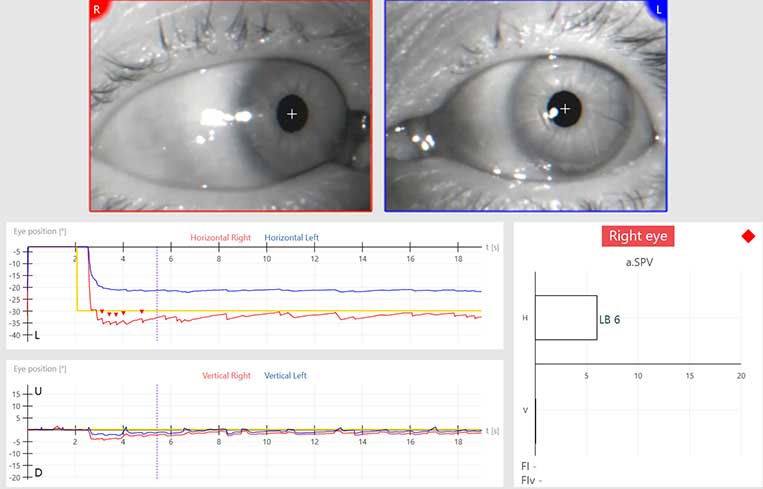Join the Interacoustics community and receive news about new products, events and much more
3 reasons why you should combine VNG and vHIT
1. VOR gain
VOR gain is never the same when measuring at different points in time. It is therefore important to be able to analyze VOR gain under various circumstances.
EyeSeeCam vHIT complies to the gold standard of gain measurements, by displaying and plotting instant gain values at 40, 60 and 80 milliseconds. The measurement at 60 milliseconds is significant, as it prevents possible covert/overt saccades from skewing the result.
In addition, we offer velocity regression and median 0-100 millisecond gains. These additional measurements are useful when there is artifact in the recordings, as these measurements average it out.

Figure 1: Instant gain values, velocity regression and median gains.
2. The clinical need to test both eyes
Single-mounted cameras are less than ideal for clinical testing. Quite often, clinicians need to have the ability to test both eyes individually. This need stems from several situations that may occur.
For example, let’s say we're dealing with a patient with a prosthetic eye on the right side. This deems the patient's right eye unfit for testing. However, certain goggles within vHIT and VNG have a single-mounted camera, which is fixed to the right eye. These goggles would be irrelevant for this patient in question, as they would not be able to test the left eye, which is the only healthy eye in this case.

Figure 2: Prosthetic eye on the right side.
A different example could be a patient with separate eye movement and separate eye disorders. As such, both eyes are impaired, and both eyes have separate impairments. In this case, the clinician would have to test both eyes individually.

Figure 3: Separate eye movement.

Figure 4: Separate eye disorders.
As seen in the examples above, not everyone's eyes work together as a perfectly matched pair. Therefore, you should have a perfectly matched pair of cameras to analyze each eye separately.
3. Use of TV for oculomotor testing
Oculomotor testing is important for a full clinical diagnosis, especially for neurology. Unfortunately, two‑dot laser stimuli from a mounted laser is often used, which is rather limited. On the other hand, using a large TV with a wide choice of computer‑generated stimuli and oculomotor patterns is what accredited literature suggests as optimal.
This is where things do get quite technical, but there are certain benefits to be gained from oculomotor testing with the EyeSeeCam vHIT and VisualEyes™ combination.
Randomization
Firstly, computer-generated stimuli allow for a randomized saccade task with a ±30° range, allowing for a more challenging neurologic substrate than a fixed saccade task1. Randomization is the gold-standard in saccade assessment.
Customization
Secondly, computer-generated stimuli can be customized according to size, color and image to accommodate for various patient populations (pediatric, geriatric, visually-impaired, etc.).
Increased testing options
Thirdly, the combination enables true optokinetic nystagmus suppression tasks with various optokinetic stimuli.
The combination also allows for sinusoidal smooth pursuit tasks with specified frequency range and age-matched gain threshold criteria by frequency2.
Finally, gaze testing is possible up to 30° laterally, the recommended target position to elicit gaze-evoked nystagmus without entering the range of endpoint nystagmus1.
References
1. Leigh, R. J., & Zee, D. S. (2006). The neurology of eye movements. Oxford: Oxford University Press.
2. Jacobson, G. P., & Shepard, N. T. (2008). Balance function assessment and management. San Diego, CA: Plural Pub.
About the authors
| Shane Seiger-Eatwell is a Master of Linguistics and Communication (cand.ling.merc.), having graduated from Aarhus University in 2018. He joined Interacoustics in January 2019 as a Marketing Communications Specialist. |
| Michelle Petrak, Ph.D. Biomolecular Electronics and Electrophysiology, is the Director of Clinical Audiology for Interacoustics DK. Her primary role is in new product developments. She is located in Chicago where she is a licensed and practicing clinical audiologist at Northwest Speech and Hearing. |
Similar Topic
Stay up to date!
Subscribe to our newsletter and receive news on new products, seminars and much more.
By signing up, I accept to receive newsletter e-mails from Interacoustics. I can withdraw my consent at any time by using the ‘unsubscribe’-function included in each e-mail.
Click here and read our privacy notice, if you want to know more about how we treat and protect your personal data.
